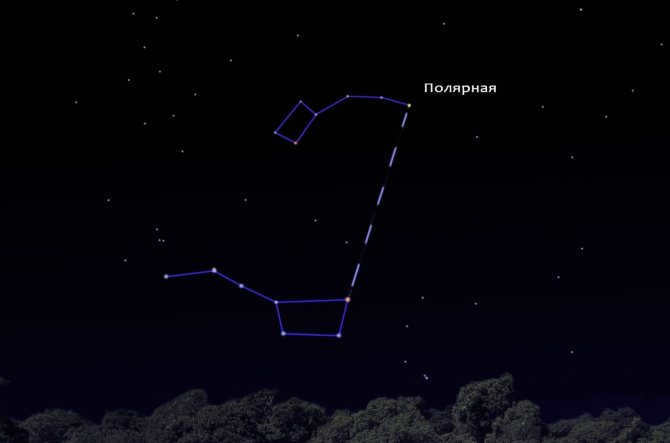
Instructions for completing a science journal for 1st grade students.
The science journal for first grade is meant to be used throughout the entire year. It begins in the autumn, continues through the winter and spring, and concludes in the summer. It is important to remember this and diligently complete the journal assignments.
When filling out the science journal, start with the cover. Make sure to sign the cover. Write your name and last name in the appropriate space, for example, Smirnova Yulia. Below, indicate the date when you started filling out the journal. Let it be September 9.
Completing page 2.
With the assistance of an adult, locate the ladle of the prominent asterism known as the Big Dipper during the autumn, winter, spring, and summer nights. Take note of its placement in the celestial sphere. Sketch the constellation. With the guidance of an adult, document the date and month of every observation.
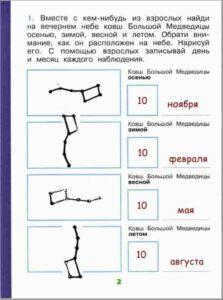
The constellation known as the Big Dipper is easily recognizable in the night sky due to its distinctive shape resembling a dipper. However, it is important to note that the position of this constellation in the sky varies throughout the year. Like all other stars, it follows a circular path around Polaris, the North Pole, which is aligned with the Earth’s axis.
Let’s now focus on depicting the Big Dipper in the autumn season.
In November, the dipper of the Big Dipper can be observed in a horizontal position, parallel to the horizon.
In February, the ladle of the Big Dipper rises with its handle pointing downward, rotating counterclockwise.
During the month of August, the bucket’s handle will be positioned upwards.
Completing page 3.
It is not a rare occurrence to witness only a portion of the moon in the sky, as it is not consistently fully visible. This is due to the sunlight illuminating only a specific part of it at any given moment.
Take the time to observe the moon over the course of a month, once a week. Sketch what the moon will appear like during each observation, and with the assistance of an adult, record the date and month of each observation.
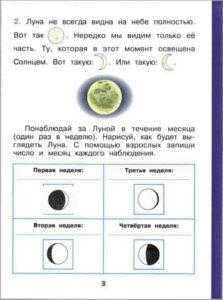
Procedure:
Every week for a month, we will take the time to observe the Moon and document its shape in our diary.
We will begin our observations two to three days after the new moon, when a small crescent shape starts to appear in the night sky. The crescent will have its horns pointing towards the left, indicating that the Moon is in its waxing phase.
As the week progresses, the crescent shape will become more round, showing that the Moon is growing.
After another week, the Moon will be in its full phase, appearing almost completely round. However, a small bump will be visible on the right side.
In the final week of our observation period, the crescent shape will once again become narrow, but this time with its horns pointing towards the right. This indicates that the Moon is now in its waning phase.
Complete pages 4-5.
Observe the weather during autumn, winter, spring, and summer. Make observations for one week during each season. Record your observations in tables. With the help of an adult, note the date and month of each observation.
This is a year-long assignment. Select a week during each season to observe the weather and carefully complete the boxes in the table.
Let’s start by filling out the table for autumn. For instance, we can choose the second week of October. Use symbols to indicate the weather conditions on that specific day. Include the date of the observation.
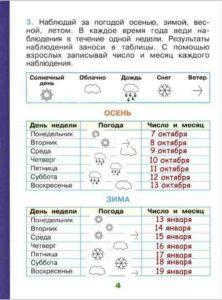
During the autumn season, there is a mixture of cloudy and rainy days, but occasionally, we may also experience clear and sunny days.
We should pay attention to the wind icon. While there is usually a light breeze, we are particularly interested in observing windy weather. Typically, this occurs during the transition from clear to rainy weather or vice versa.
Next, we will focus on winter and select the second week of January for our observations. We will record our findings in the table using the same method.
Winter weather is characterized by clear, frosty conditions and frequent snowfall. Rainfall during winter is extremely rare.
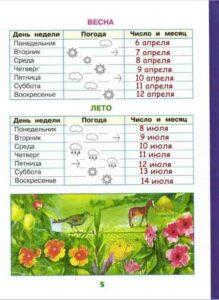
Proceed to the next page and anticipate the arrival of spring. Opt for the second week of April to conduct your observations. During this period, the weather is typically characterized by clear and sunny days, although occasional rain and cloud cover may occur.
Lastly, we have one more observation to make during the summer season. Let’s select the second week of July for this purpose. This period represents the peak of summer, characterized by minimal rainfall and predominantly clear and sunny skies.
Conduct experiments with a magnet to ascertain the objects it is capable of attracting and those it is not. Identify the objects that the magnet successfully attracts.
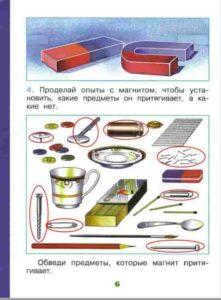
The image displays a variety of objects composed of different materials. It is important to note that magnets only attract objects made of iron. Materials such as glass, plastic, eraser, and wood are not magnetic and will not be drawn to the magnet.
It is worth mentioning that spoons are typically not attracted to magnets either due to being made of stainless steel, which is a complex alloy lacking magnetic properties.
Although I was unable to identify all the objects in the image, the following items should be magnetized:
A metal button, a key, a weight, small nails, a paper clip, a pin, a large nail, and a screw. Let’s encircle them with a pencil.
Sometimes, a tassel is encircled due to the presence of a metallic covering, although it could be composed of an aluminum alloy that doesn’t possess magnetic properties.
Complete page 7.
Select a tree in close proximity to your residence and monitor it across all four seasons. How will it appear during the autumn, winter, spring, and summer? Sketch it accordingly. With the assistance of an adult, record the name of the tree, as well as the date and month of each drawing.

Feel free to select any type of tree, such as an apple tree, to illustrate.
During the month of October, the apple tree sheds all of its leaves, and we depict the bare branches and fallen leaves on the ground.
In January, the apple tree becomes adorned with a layer of snow, which blankets its bare branches.
Come April, the apple tree initiates its blooming phase, with minimal leaves present, but its branches adorned with exquisite soft pink or white flowers.
By August, the apple tree stands in full splendor, boasting lush green leaves and nearly ripe apples.
Observe the behavior of your pet (e.g., cat, dog, hamster, parrot) if you have one at home. Collaborate with an adult to document the species and name of your animal. Capture a drawing or photograph of your pet and affix it in your notebook. Make an effort to memorize and record any fascinating observations you make with the assistance of an adult.

Record the name of your beloved pet, for instance it’s a feline. Below, jot down its nickname, let’s say it’s Murka.
Within an empty box, sketch a portrait of the feline or insert a photo of her.
Beneath, document her routines, intriguing observations of her behavior. We’ll write down everything that captivates, pleases, or amuses us. Describing the physical appearance of the animal is unnecessary, as we have a photograph for that purpose.
Completing page 9.
Calculate and record in the boxes the number of superfluous items (trash) that accumulate in your residence throughout the day.
An empty milk container can be transformed into a bird feeding station. What other creations can you fashion from discarded objects to avoid disposal? Accomplish this task and illustrate it.

Take one day to observe the types and quantities of waste produced in your household. This may include plastic milk or soda bottles, yogurt containers, glass, and tin cans.
Record the numbers in the designated boxes.
There are numerous creative and practical crafts that can be made from unwanted objects and trash. Let’s explore two possibilities.
Creating a unique vase using a burnt-out light bulb is a simple and creative project. To make this DIY vase, gather the following materials: an old burnt-out light bulb, a piece of cardboard, and some glue.
With the help of parents, carefully create a hole in the base of the light bulb. Once the hole is made, secure the bulb onto a sturdy stand made from the piece of cardboard. Afterward, pour water into the bulb. Now, you can elegantly display your favorite flower by submerging its stem into the water-filled bulb. Voila! Your one-of-a-kind and eye-catching vase is complete.
Option 2.
Transforming a plastic bottle into a pencil case. The necessary materials are two plastic bottles and a used zipper.
To start, carefully slice the bottles in half, discarding the upper sections. With the guidance of our parents, we can then attach the zipper to the lower halves. Once completed, the pencil case can be used to store pencils or pens by simply zipping it shut. This convenient and eco-friendly solution is now ready for use.
Complete page 10.
With the help of grown-ups, collect some snow from the street and from the depths of the park or forest in cups. Observe which cup of melted snow is more contaminated and provide a reason for it. Illustrate the appearance of the melted snow water in each cup.

Why don’t we try an experiment with snow? We can take two cups, one filled with snow from the park and the other filled with snow from the street near our house. Once we bring them home, we can let the snow melt and observe the differences. We’ll notice that the melted water from the park will be clear and transparent, while the water from the street will be cloudy and dirty.
The snow on the street collects dirt particles from car exhaust, smoke, soot, and other pollutants. As a result, the water obtained from this snow becomes dirty.
On the other hand, the snow from the park doesn’t have these particles, so the water from it will be almost pure.
Let’s draw a picture of what we observed.
Get rid of litter in a designated section of the woodland or recreational area (for example, an open space or a trail).
Embark on a stroll to a neighboring park during the spring season and observe the extent of debris that has accumulated there throughout the winter months. Record your observations in your personal log. You may come across a variety of items such as bottles, cans, wrappers, bags, boxes, and other forms of rubbish.
Gather the litter you come across in a designated bag and dispose of it in a specifically assigned trash receptacle. Contribute to the cleanliness of your park!
Finishing page 11.
Once you have finished brushing your teeth, it’s time to get creative! Take out your crayons and let’s paint a square. In the morning, use a sunny yellow crayon to color the square, and in the evening, switch to a calming blue crayon.

This task is the simplest scientific journal assignment. Over the course of one week, while carrying out your morning and evening tooth brushing routine, make sure to color the appropriate square on the page.
Now you have gained the knowledge on how to accurately complete a science diary.
August is renowned for its magnificent starry skies adorned with sparkling diamonds. During a recent weekend, as I embarked on a canoe rafting trip along the Snigiryovka river, I had the opportunity to spend the night at a high promontory, where I captured some breathtaking images of the celestial heavens. I managed to successfully photograph the constellation of the Ursa Major, also known as the Big Dipper, which I will be sharing with you today.
One of the images I have is a view through a window, where the leaves of a tree nearby are visible, and the tops of pine trees on the opposite bank of the river perfectly align with the shape of the constellation.
In case it’s not immediately recognizable, I have taken another photo where I have outlined the constellation with lines for clarity.
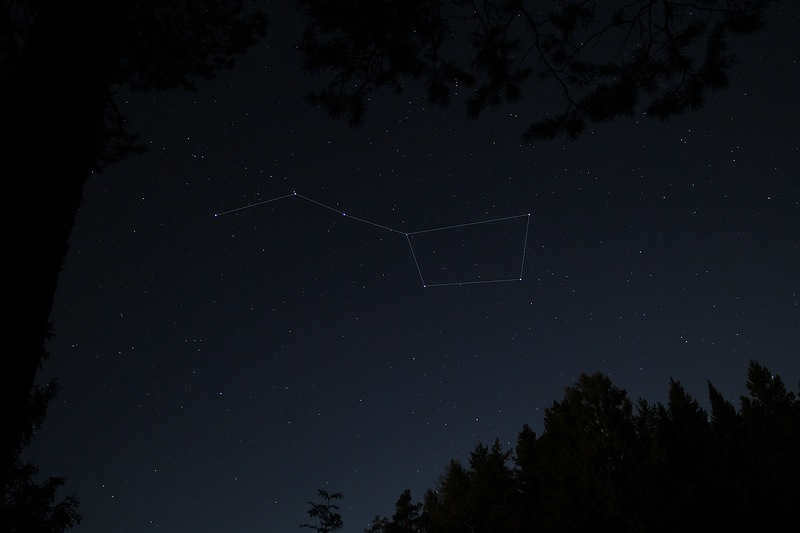
What a magnificent sight! The sun is slowly disappearing over the horizon, casting a gentle glow on the world below. The night sky is adorned with countless twinkling stars, resembling a sea of diamonds. The majestic trees, touched by the soft light of the nearly full moon, glisten with a subtle silver hue.
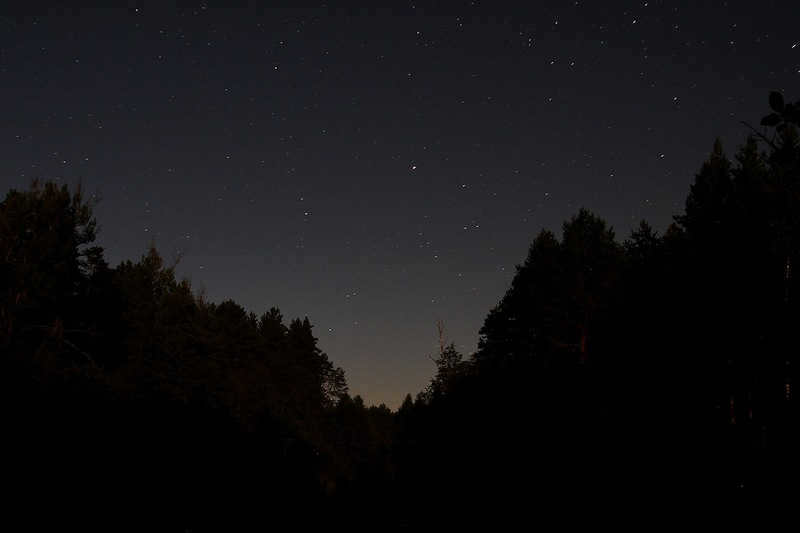
The fire is dying down, casting a crimson glow on the branches of the fir tree, beside which we took a break on the summit of a towering cliff overlooking the Snigiryovka river. The enchanting melodies of a wargan and a tambourine, crafted from authentic leather and carefully dried over the crackling flames, drift into the vast emptiness.
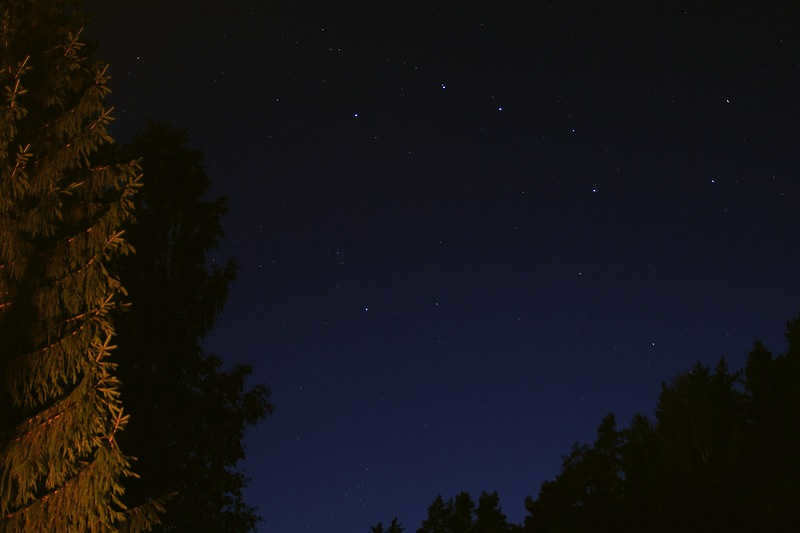
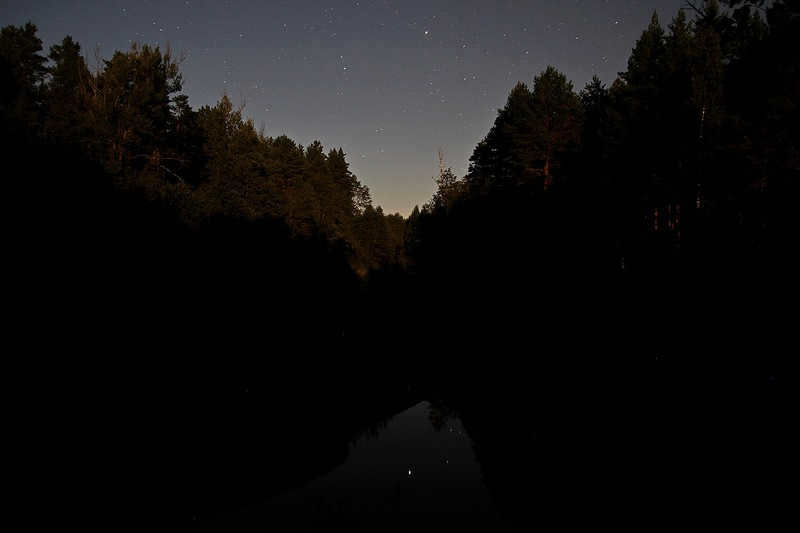
Let us conclude our poetic tangent and return to our constellation. Throughout history, this celestial formation has been recognized by various names among different cultures. In ancient Russia, it was known as the Elk, while others referred to it as the Plow, Wagon, or Seven Wise Men. According to Greek mythology, the beautiful nymph Callisto was transformed into a Bear by Zeus to protect her from Hera’s wrath. In Chinese astronomy, the seven stars of the dipper are known as the Northern Bucket (Beidou). In ancient times, the handle of the bucket nearly pointed towards the pole and was used by the Chinese for timekeeping. The Latin designation for this constellation is Ursa Major, or the Great Bear. Interestingly, the Big Dipper can be found depicted on several flags, including the flag of Alaska alongside the North Star, the flag of the Irish Radical Organizations (IRA), and the ancient flag of White Sea Karelia.
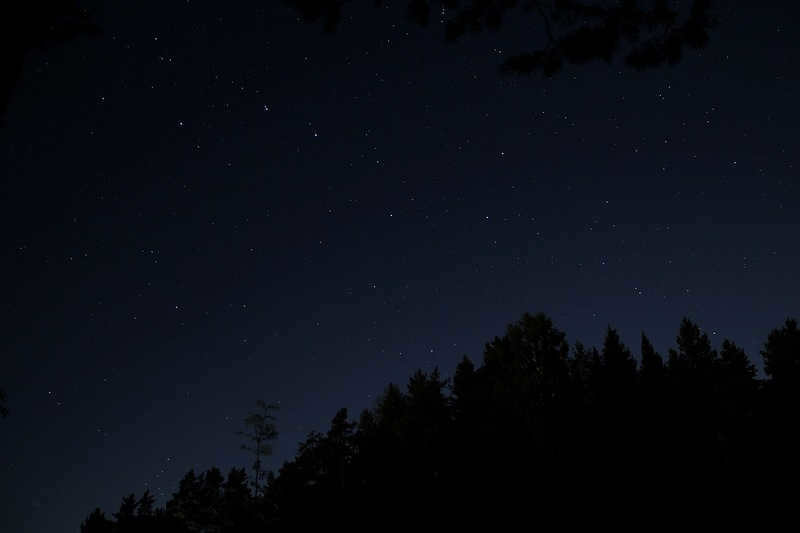
The stars that create the constellation known as the Big Dipper are indicated on this diagram. Historically, these stars have been designated using letters from the Greek alphabet, with the brightest star being labeled as alpha and subsequent stars being named in descending order of brightness. However, this naming convention does not hold true for the Big Dipper, as epsilon is actually brighter than alpha. Additionally, each of the stars in the constellation has its own individual name. Like many other stars, these names have Arabic origins, as Arab culture served as a crucial link between the decline of the Roman Empire and the onset of the Renaissance. Let us explore each of these stars in greater detail.
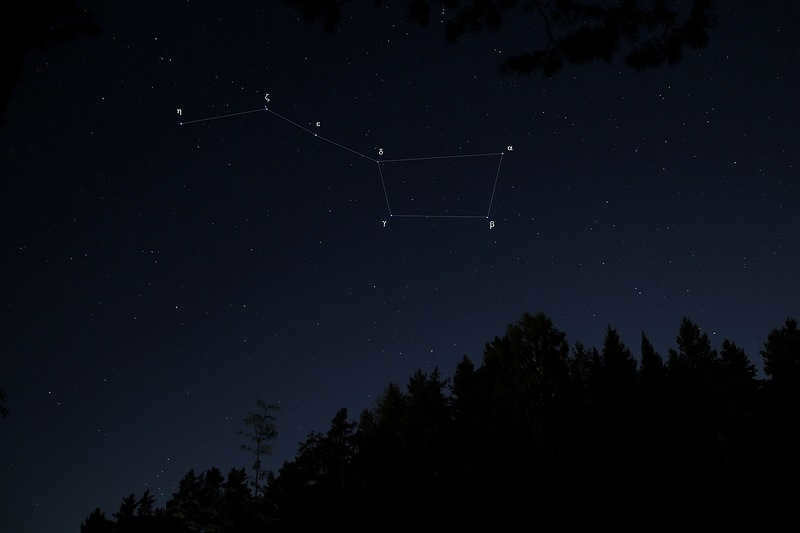
Alpha, Dubhe. signifies “bear” in Arabic. Its name is derived from the Arabic ahr ad-dubb al-akbar, which means “the posterior of a large bear”.
Beta (beta) – Merak – refers to “loins.” It shines 69 times brighter than the sun in its star system.
By utilizing these two stars, one can locate the North Star, which points towards the north. To accomplish this, mentally draw a line through the two stars (Dubhe and Merak) of the “wall” of the dipper, opposite to the “handle”, and extend it to a distance five times greater than the distance between these outermost stars. Approximately at the end of this line lies Polaris. The direction towards Polaris aligns with the north, and its height above the horizon corresponds to the observer’s latitude.
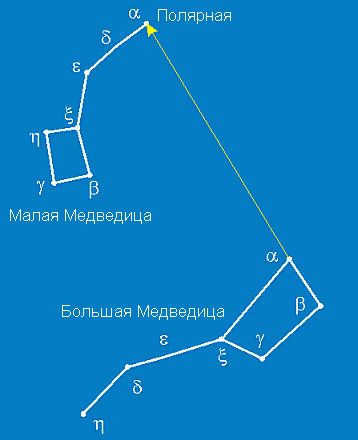
γ – Thekda – “hip.”
δ is Megrez – “root” (the start of the tail). It is the faintest star in the Big Dipper, with an apparent stellar magnitude of +3.32. It is located 81 light-years away and is about one and a half times larger and heavier than the Sun, while being 14 times brighter.
ε (epsilon) – Aliot – the brightest star in the constellation, shining 0.05 magnitudes brighter than Dubhe. It should technically be the alpha, but it is historically not recognized as such. It is the 33rd brightest star in the visible part of the sky. This star has a historical significance in maritime navigation.
ζ (zeta) – Mitzar. – “girdle” or “loincloth.” Another star called Alcor can be seen next to Mitzar by people with good eyesight. Seeing Alcor is a traditional way to test one’s eyesight. This pair is also known as the “Horse and Rider” and is the most well-known double star system. The full-size images on this page also display both stars.
There is a legend that in ancient Egypt, young boys who could distinguish between these stars were recruited into the pharaoh’s elite troops. This was considered proof of their sharp eyesight. Variations of the legend mention Greek archers or Indian hunters. There is no confirmation of the authenticity of these claims. Additionally, Mizar and Alcor can be easily distinguished as individual stars even with average visual acuity.
η (also known as this one) is commonly referred to as Benetnash or Alqaid. The name Benetnash or Alqaid is derived from the Arabic phrase al-qaid banat nash, which translates to “leader of the mourners.” This name symbolizes the depiction of the constellation of the Big Dipper in Arabic folklore, where it is seen as a funeral procession with mourners and a leader.
Benetnash is the third brightest star in the constellation and ranks 35th among the brightest stars in the sky. It is located approximately 100 light-years away from the Sun. With a surface temperature of 22,000°K, it is considered one of the hottest stars visible to the naked eye.
The Big Dipper is a well-known constellation in the northern hemisphere. It is comprised of seven stars that form a distinct shape in the sky. This shape resembles a dipper, and by following the direction of the two outermost stars, Dubhe and Merak, one can find Polaris, also known as the North Star. Among these stars, the brightest one is Aliot, and the most famous double star system is Mizar and Alcor. It is said that those who can differentiate between these two stars have exceptional eyesight.
Within the Big Dipper constellation, there are two spiral galaxies that can be observed using a small telescope: M81 and M101. M81 is particularly interesting as it shares many similarities with our own Milky Way Galaxy. Additionally, in close proximity to M81 is the small galaxy known as M82, which experienced a powerful explosion millions of years ago. This event holds great significance in the field of astronomy as it provides insights into the formation and evolution of galaxies.
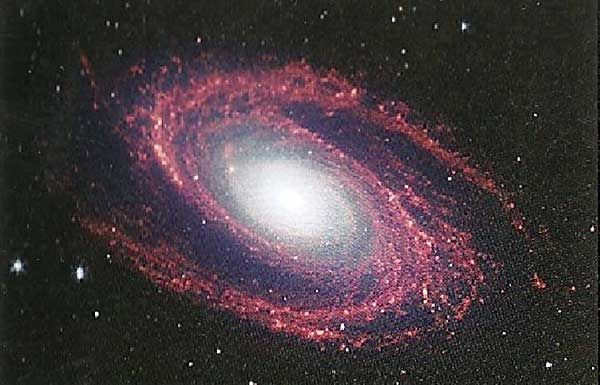
A composite image of the spiral galaxy M81 was created using ground-based and space-based images.
Another fascinating object in the constellation Ursa Major is the planetary nebula M97, also known as the “Owl” due to its resemblance to this bird. It can be easily observed through a small telescope, as the total luminosity of the nebula is 11″.
In the ancient Greek legends, Artemis, the goddess of hunting, would often wander through the mountains and forests in search of wild game. One of her most alluring companions was a maiden named Callisto. When Zeus, known as Jupiter in Roman mythology, laid eyes on Callisto, he was immediately captivated by her youthful beauty. However, it was against the rules for Artemis’ handmaidens to marry. Determined to have Callisto for himself, Zeus devised a cunning plan and transformed into the likeness of Artemis. With his clever disguise, Zeus was able to seduce Callisto, resulting in the birth of their son, Arcades. As Arcades grew older, he developed exceptional hunting skills, following in the footsteps of his divine parents.
Hera, the wife of Zeus, discovered her husband’s affair and unleashed her anger on Callisto, transforming her into a hideous, sneering bear. Later, Callisto’s son Arcadus encountered her in the forest, unaware that it was his own mother, and shot her with an arrow. At the last moment, Zeus, who was protecting Callisto, deflected the arrow.
In response, Zeus transformed Arcadus into a small bear cub and brought him and the cub to the heavens. There, he left Callisto to shine as the stunning constellation of the Big Dipper, while Arcadus became the constellation of the Little Dipper.
The constellation can be seen at latitudes ranging from -30° to +90°. The optimal time for observing it is during the spring months of March and April. It is clearly visible across the entirety of Russia. Adjacent constellations include the Dragon, Giraffe, Lynx, Lesser Lion, Lion, Veronica’s Hair, Hound Dogs, and Wolopassus.
One of the most well-known constellations that can be easily spotted in the night sky is the Big Dipper. This constellation, located in the northern hemisphere, is recognizable by its distinctive shape resembling a dipper. During the autumn season, it can be found in the northern part of the sky.
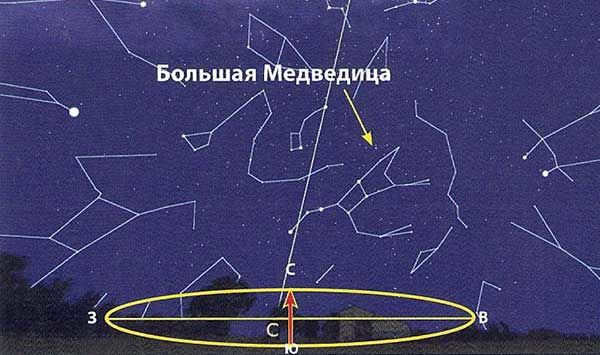
During the winter season, the Big Dipper shifts its position towards the east, while the “handle of the bucket” moves in a downward direction. This movement can be visually interpreted as the Bear ascending into the sky. Many people are familiar with the technique of locating Polaris by using the two stars on the right side of the bucket, as they serve as a guide towards the desired object.
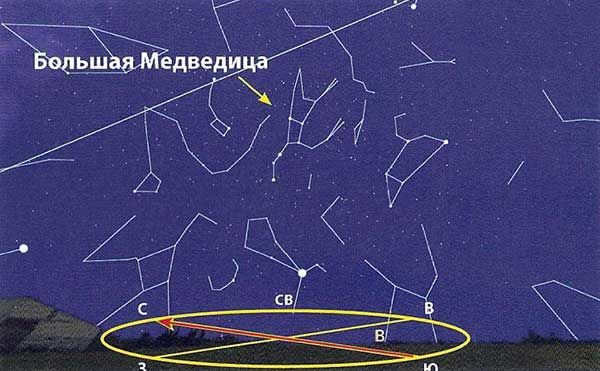
During the spring season, the prominent constellation known as the Big Dipper starts its journey downward from the celestial realm and progresses towards the west. As summer comes to a close, this constellation reappears in the northern sky, assuming a horizontal orientation. By utilizing the iconic "bucket" shape of the Big Dipper, one can effectively determine the local time with great accuracy. The step-by-step procedure for solving this specific task can be readily accessed on the Internet.
The constellation known as the Big Dipper – is the most well-known arrangement of stars in our celestial sphere. Its shape is easily recognizable, but what makes it truly remarkable is its visibility throughout the year: in the middle and northern latitudes, the dipper never dips below the horizon. These two characteristics have made the seven prominent stars of the Big Dipper a crucial navigational tool in the night sky of the northern hemisphere since ancient times. By utilizing this stellar guide, one can locate nearly all the constellations in the northern hemisphere, as well as the vital North Star – Polaris.
In Europe and Asia, the Big Dipper had various names and was associated with numerous legends. The ancient Greeks and Romans referred to it as the Chariot or Voz, as it resembles a cart with a handle. This name was also common in Russia and among the Germanic tribes. In Irish mythology, the seven stars of the Big Dipper were known as the Chariot of Tsar David, named after an ancient ruler of Ireland. In English folklore, the constellation represented the house of the legendary King Arthur, and the ladle was called Arthur’s Chariot. The ladle was also referred to as the Plow, which was used by peasants from the Middle Ages onwards.
The bucket of the Big Dipper can be seen over Mount Tsubakaro in Japan. Photo: Takashi Noma
In India, instead of referring to a plow, cart, or chariot, the bucket of the Big Dipper was associated with the god Brahma and his six sons by the local people. The star zeta of the Big Dipper, known as Mizar today, represented the god himself, Vasishtha. This star, located on the bend of the handle of the dipper, stood out among the others. The remaining stars of the ladle represented Brahma’s sons and were named Kratu, Pulaha, Pulastya, Atri, Anghiras, and Marisi, from right to left. It is no surprise that these seven stars were regarded as symbols of wisdom by the ancient Indians and were often referred to as the Seven Sages.
Incidentally, in Sanskrit, this constellation was referred to as Riksha. In its feminine form, it signified “star”, “bright”, “shine”. However, in its masculine form, it meant… “bear”! According to one hypothesis, the term “Riksha” later got confused with “Rishi” and linked this star pattern with the Seven Sages of India. Eventually, this name made its way to Europe: the constellation began to be known as the Seven Wise Men of Greece, and later on, as the Seven Defenders of Christianity… In numerology, the number 7 came to be associated with wisdom and a philosophical outlook on life.
Where can the Big Dipper be found in the sky?
The location of the Big Dipper in the sky varies throughout the year. During late summer, autumn, and early winter, it can be seen in the evenings towards the northwest and north, positioned relatively low above the horizon in its characteristic horizontal shape.
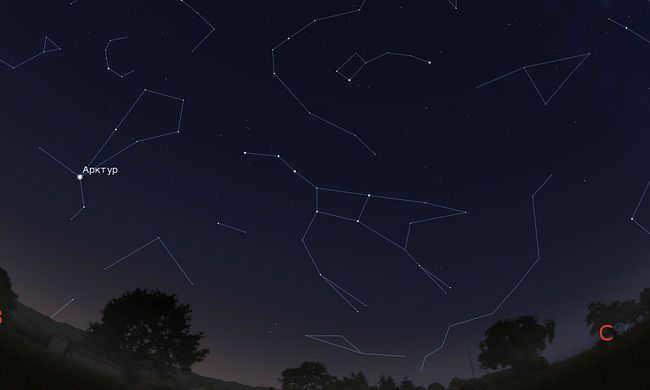
In the first half, you can see the ladle of the Big Dipper in the evenings in the northwest, parallel to the horizon. Image: Stellarium
As winter comes to an end, the dipper takes a strong tilt and becomes visible in the northeast during the evenings, almost standing on its handle! In spring, you can spot it almost directly above you; it appears to be upside down when it does so. During summer evenings, the dipper is high up in the west; it is once again tilted towards the horizon, but this time with the dipper instead of the handle.
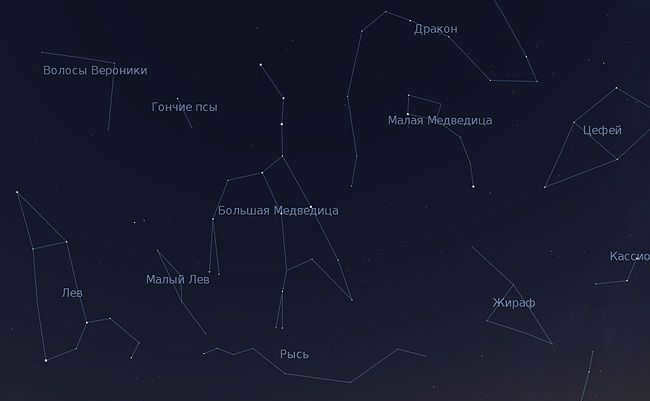
In the summer, the Big Dipper is tilted at a strong angle, with its handle pointing towards the bright star Arcturus. This can be observed in the night sky. Image source: Stellarium
It should be noted that in southern Europe and Africa, the Big Dipper sets below the horizon at its lowest point in its path across the sky. This phenomenon can be observed partially or completely depending on the location. However, this was not always the case. According to various myths and legends, a few thousand years ago, the Big Dipper, also known as the nymph Callisto who was transported to the heavens by Zeus, was believed to be a non-setting constellation due to the will of Hera, the wife of Zeus. In revenge for her husband’s treason, she pleaded with Poseidon, the god of the sea, to prevent the Bear from entering his kingdom.
Why is the dipper now partially over the horizon in the southern part of Greece? The reason is that the earth’s axis of rotation, which we perceive as the pole of the world around which all the stars seem to revolve, is gradually moving across the sky. This phenomenon, known as precession, was first discovered by the ancient astronomer Hipparchus over 2000 years ago. Over thousands of years, due to precession, the celestial pole has shifted from the Big Dipper to Polaris, causing it to move further away from the seven stars and causing the dipper to trace a larger circle around it.
The Big Dipper and Polaris.
What is the primary purpose of the Big Dipper? It serves as a guide to Polaris. Let’s locate Polaris using these seven stars. Take the two stars on the outer edge of the dipper (Merak and Dubhe) and mentally connect them with a line. Then extend the line from Merak to Dubhe five times its original distance. That will lead you right to Polaris.
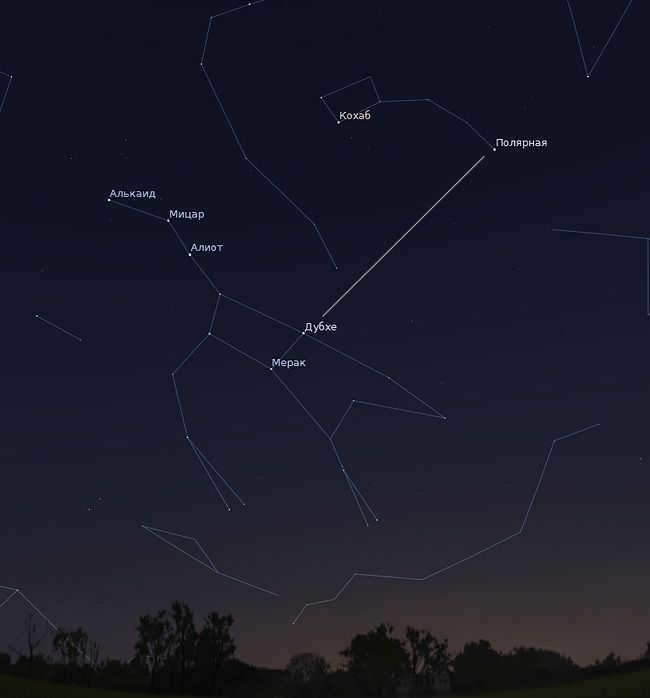
Even though the Big Dipper’s position varies throughout the year, Polaris always remains in the same spot. The technique of locating Polaris using the outer stars of the Big Dipper is effective regardless of the season. Image: Stellarium
Contrary to popular belief, Polaris is not particularly bright; its brightness is roughly equivalent to that of the stars in the Big Dipper.
What makes this method fascinating is that it works for finding Polaris at any time of the year and at any time of day (even during a winter day above the Arctic Circle!). While the Big Dipper changes its position in the sky, Polaris remains constant! It serves as the focal point, the “anchor in the sky,” around which all other stars revolve.
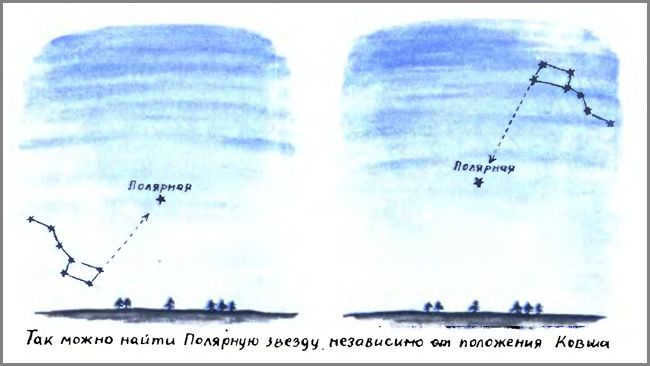
The two outermost stars of the Big Dipper, Dubhe and Merak, always point towards Polaris no matter where the constellation is located in the night sky. Image: G. Rey. Stars
Van Gogh and the Constellation Ursa Major
The sight of a starry sky evokes strong emotions in many people. While it may be challenging to fully appreciate its beauty in a modern city, there are still places on our planet where the stars can be seen in their full splendor.
A hundred years ago, when street lighting was still dim, people could study the night sky even in large cities and attempt to capture its mysterious depth. The Dutch artist Vincent van Gogh depicted his impressions of the stars in a series of paintings, one of which is titled “Starry Night over the Rhone”.
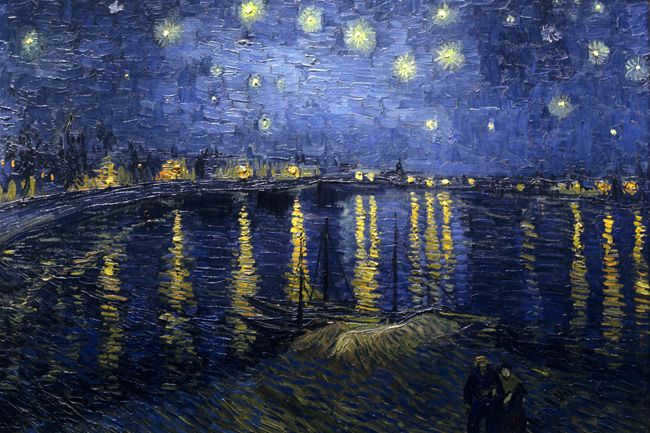
The painting known as “Starry Night Over the Rhone” is likely the most well-known representation of the constellation Ursa Major, also known as the Big Dipper.
In my son’s first grade class, he had a project about studying “the world around us.” One of the assignments was to observe and sketch how the Big Dipper constellation changes its position in the sky at different times of the year. Instead of using a program to map out the starry sky, which can be convenient but not very engaging for a child, we decided to find a way for him to truly understand the concept. After some searching, we came across a helpful website called AstroGalaxy that explained the topic in a way that was accessible to children. Inspired by this, we decided to create a rotating model of the Big Dipper. Here is how our project turned out!
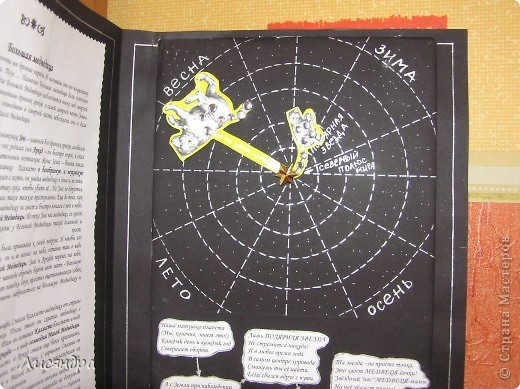
And here we have “winter” and poems, which were taken from the aforementioned website, I have slightly modified them (may the authors forgive me).
Our mother planet
(We are aware, of course!)
Every single day and every year
Rotates around.
And from the Earth
♪ And from the Earth
It’s not the Earth that is spinning
But rather all the stars and the moon.
Only the POLAR STAR
Doesn’t move at all!
And in each season of the year
In the center of the circle
You can find it
If you have lost your way
The axis of the earth
# It’s pointing towards it
You can be certain
Where it is, it’s the NORTH!
That star is not just a tiny dot
It is the tail of the Ursa Minor!
The starry snout of the Ursa Major
That’s the star snout of the Ursa Major
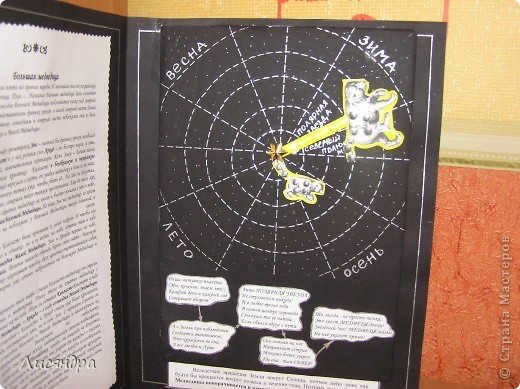
Now, all that remains is to finalize the design. The legends regarding the Great Bear are inscribed on the left side. Finally, I have uncovered the answers to the inquiries that have plagued me for so long: the reason behind the bear’s appearance in the dipper, the rationale for its menacing depiction on ancient celestial maps, and even the existence of its lengthy tail. Additionally, I have discovered the identity of the Little Bear. Although captivating, the tale is also permeated with tragedy…
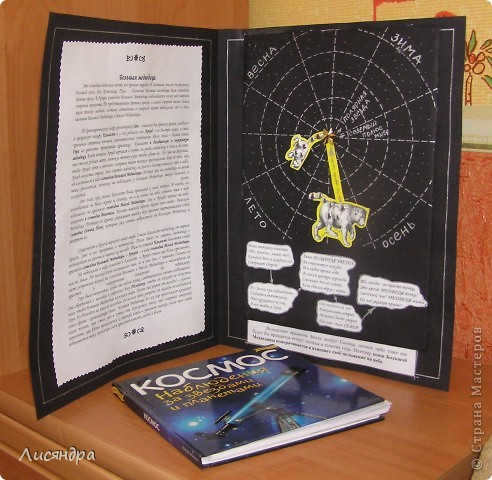
This is the cover page. It showcases the constellation and its primary stars. Furthermore, it includes modified poems composed by me.
THE LARGE URSUS MAJOR
I identify it by its COVE!
Here, seven stars illuminate the sky,
And these are their designations:
DUBHE illuminates the darkness,
Beside it, MERAC burns brightly,
And adjacent to them are FEKDA and MEGRETZ,
Arranged by the divine.
Adjacent to the handle lies the twist.
This is the precise location of the ALIOT.
And positioned behind it are MICAR and ALICORUS.
(These two radiate joy).
Completing the scoop
An astral body known as BENETNASH.
Further explanation: The star formation commonly referred to as the Big Dipper (scientifically known as Ursa Major) is easily recognizable, even to the youngest of individuals. Spotting the seven prominent stars arranged in the shape of a large ladle is a simple task when gazing into a clear night sky. However, the dipper is merely a fragment of the entire constellation, representing the tail and a portion of the celestial bear’s body. To the right and below the handle, several additional stars can be observed, constituting the bear’s paws and head.
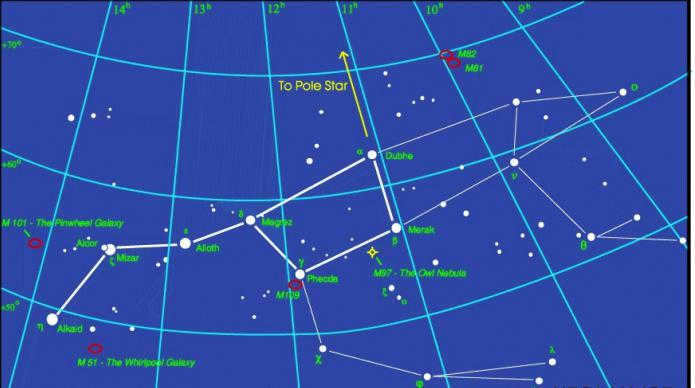
Throughout history, individuals have been fascinated by the night sky. There is an inherent allure in gazing at a crisp moon and distant stars. It brings about a sense of tranquility and contentment.
A curious observer will eventually start to discern patterns in the sky – peculiar groupings of stars that create various shapes. One such constellation that catches the eye is the Big Dipper. In this article, we will delve into its intricacies.
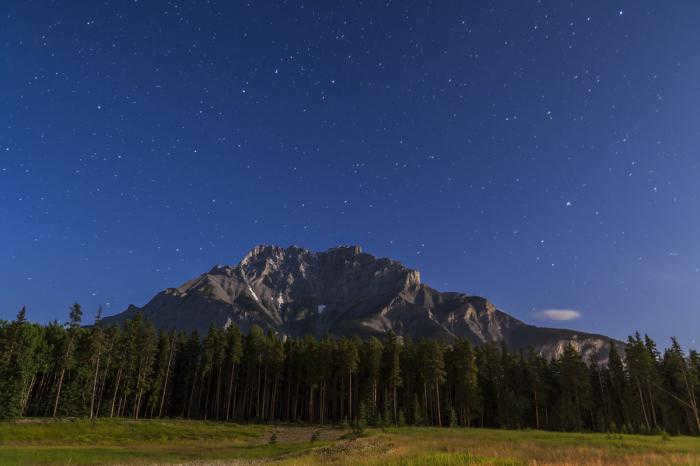
The Ancient Perception of the Big Dipper
The Big Dipper has been a prominent constellation in the night sky for countless generations. It holds significance in the cultural beliefs of various peoples throughout history.
The Hindus were among the first to observe and name the Big Dipper, referring to it as “Sapta Rishi” in Sanskrit, which translates to “seven sages”. In Chinese astronomy, it was known as the “Northern Bucket” and was used as a tool for timekeeping by the resourceful Chinese.
The Greeks discovered a fascinating explanation for the stunning constellation of stars in the heavens. Naturally, the Big Dipper is associated with a myth. It recounts the tale of the mighty Zeus who became enamored with the exquisite nymph Callisto. Unfortunately, Zeus’ domineering wife, the goddess Hera, disapproved. To protect the lovely maiden from the wrath of her overbearing husband, the God of Thunder transformed her into a Bear and placed her among the celestial realms. Today, the radiant Callisto brings joy to all admirers of the starry sky with her gentle, sparkling radiance.
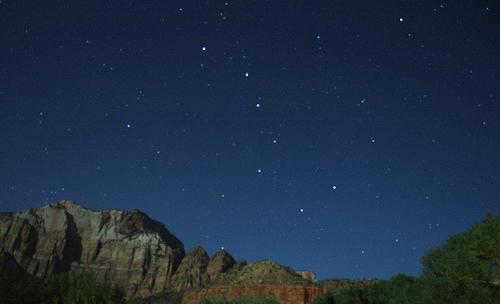
A dazzling ladle in the nocturnal heavens.
Now, let’s examine the ladle of the Big Dipper. It reaches its peak splendor during the autumn season. From a scientific perspective, this constellation ranks as the third largest in terms of area, trailing only Hydra and Virgo. It spans a vast expanse of 1,280 square degrees. The Big Dipper (also known as the bucket, as depicted in the photo above) boasts a visible section composed of seven luminous stars. Let’s outline them:
- Dubhe – The Bear;
- Merak – The Lumbar;
- Fekda – The Thigh;
- Megretz – The Beginning of the Tail;
- Aliot – The Curdle;
- Mitzar – The Loincloth;
- Benetnash – The Leader of the Mourners.
All of these names are of Arabic origin and represent the seven radiant stars that comprise the legendary ladle.
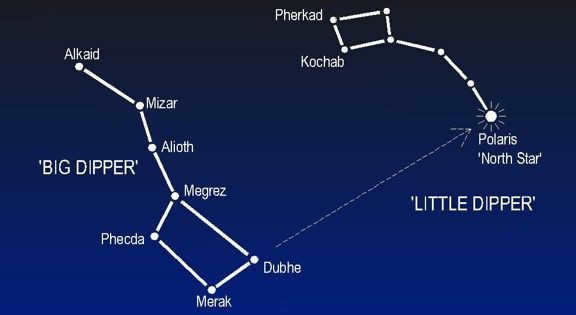
Position in the celestial sphere
The constellation of the Big Dipper is an indispensable part of the night sky. In autumn, it can be found in the northern region of the celestial sphere. It is visible between 3-4 AM above the northeastern horizon. A useful guide is the handle of the Big Dipper, which points towards the location of the sunrise.
The Big Dipper – a pathway to exploring astronomy
Novices should acquaint themselves with locating the Big Dipper during the autumn season (see photo of the constellation below). This collection of stars is among the most prominent in the nighttime sky. Such an exercise serves as a valuable introduction for young amateur astronomers, preparing them for a more comprehensive examination of the celestial heavens, including:
- identifying less conspicuous constellations in the sky. Seasoned astronomers utilize the Big Dipper as a reference point for locating other stars;
- engaging in captivating sky observations throughout the year. Noteworthy changes can be observed in the positions of familiar stars, moonrise times, and more;
- initiating the first calculations. Over time, one becomes familiar with the angular distances between the stars of the dipper.
- The initial experience of using a handheld telescope allows young astronomers to discover stars that are normally invisible to the naked eye. This includes the observation of double and variable stars, and there is even a possibility of observing the explosive galaxy M82.

The Big Dipper during Autumn
The positioning of the constellations is largely influenced by the time of year. The Big Dipper (dipper) during autumn is no exception to this pattern.
The autumn night sky is not particularly abundant in stars. Even the traditionally vibrant Big Dipper constellation appears dimly. The bucket of the Big Dipper during autumn is situated in the northern sky beneath Polaris, with its tail pointing towards the west. Cassiopeia can be seen directly overhead.
In the eastern sky, the Pleiades constellation rises prominently, and the bright star Aldebaran, located in the Taurus constellation, shines clearly beneath it. During this time, two bright stars ascend in the northeast, which an experienced stargazer would quickly recognize as Gemini.
So, let’s summarize the constellations that can be observed in the northern part of the night sky during the autumn:
- The Great Bear;
- The Little Bear;
- Gemini;
- Taurus;
- Lyra and Cygnus.
Geometry of the Celestial Dome
If you have located the ladle of the Big Dipper during autumn, you can continue your search for other familiar stars for an hour or two. The most important thing is to have a genuine desire and, of course, a star map would be helpful.
Now let’s take a look at the southern part of the sky. This is where Andromeda and Pegasus rise every autumn. In the upper left corner of the sky, you will find two stars from the first constellation, followed by three stars from the second constellation without fail.
Andromeda is comprised of four widely spaced stars. The constellation itself is situated below Cassiopeia. Andromeda vaguely resembles the shape of a bow. The latter is aimed directly at the Pleiades and Taurus. It almost gives the impression that an arrow is poised to be released from the bow and fly off to the left, towards these constellations. However, this is purely a flight of fancy and has no connection to the grandeur of the celestial sky.
Two tiny stars can be observed beneath Andromeda – these are Aries. And below them are numerous luminous dots – this is the constellation of China. Aries and China can only be seen when the weather is clear.
In Pegasus, it is important to keep in mind two additional stars situated to the right, in addition to the three prominent ones. The constellation itself resembles a pair of horns, almost as if it is trying to gently prod the nearby Swan.
Illustration: the autumnal appearance of the Big Dipper’s handle


Observing a clear sky can truly inspire creativity. It’s not unusual to feel inspired to engage in some creative work after gazing at the night sky. Some may be motivated to write a captivating story about their nocturnal experience, others may feel compelled to dance to their favorite music, and yet others may be inspired to sketch the luminous bucket.
In this article, we will focus on the art of sketching the Bear.
Attempt to convey some of your emotions through your artwork, and it will result in something truly captivating. As evidenced, sketching the handle of the Big Dipper during the autumn season is surprisingly effortless.
The Significance of the Big Dipper in Society


- The Big Bear’s Dipper is a group of stars that resembles a funeral procession with two mourners represented by the stars Benetnash;
- Arctos is the ancient name for the Big Bear’s Dipper, which originated from the time of nomadic hunters. This demonstrates the enduring fascination humans have had with the night sky throughout history;
- The state of Alaska features the Big Bear’s Dipper on its flag;
- The Big Bear’s Dipper has also made appearances in anime. The character Kenshiro from the popular manga series “Fist of the North Star” has a scar on his chest that resembles the shape of a ladle. Russian viewers can currently enjoy the three-part space novel “Fist of the North Star: New Era”.
- The Museum of Modern Art houses an artwork titled “The Big Dipper”. Its name derives from the arrangement of smoking cigarettes that form the shape of the well-known constellation.
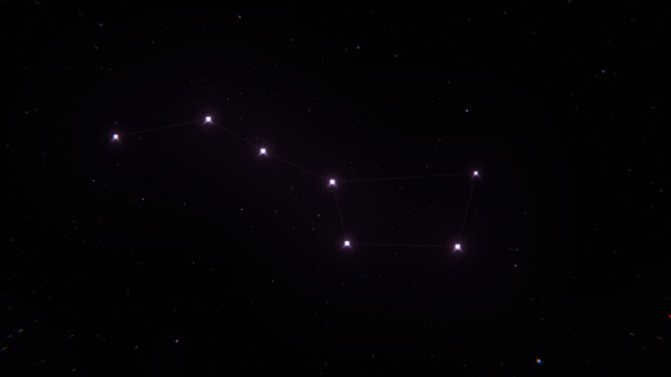

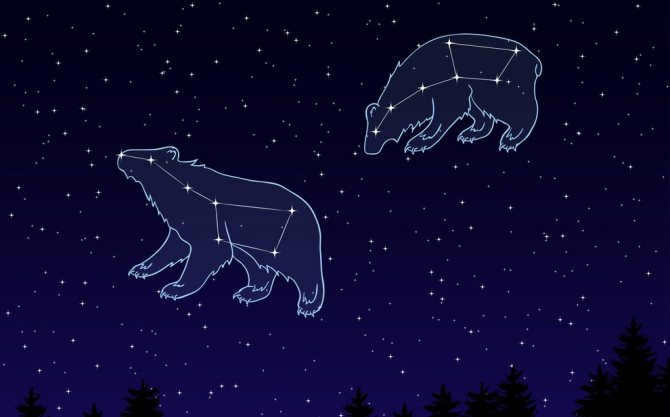
Actually, the night sky is quite a disorganized sight. It takes a highly imaginative mind to see, much like the ancient people did, the scattered stars forming human figures, animals, and various objects. However, there are some truly remarkable star formations that capture one’s attention! One of these captivating patterns is the renowned Big Dipper, which stands out prominently in our celestial sphere. Interestingly, the Big Dipper is not a constellation on its own, but rather a part of the Ursa Major constellation. So, how can one locate the complete Ursa Major constellation in the sky?
Before anything else, you must locate the ladle in question.
An Overview of the Big Dipper: Appearance, Description, and Traits
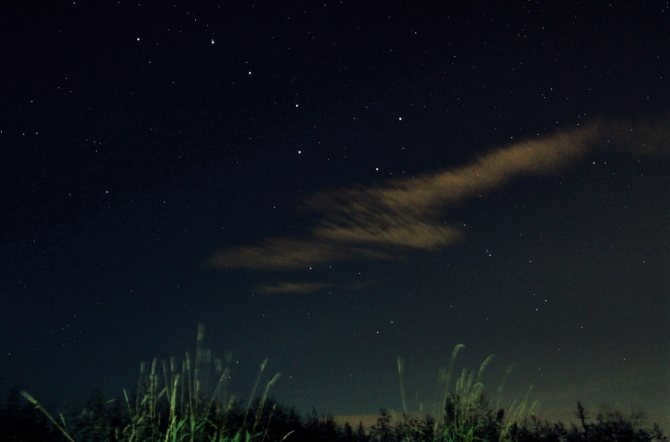
Image of the Great Bear in the summer night sky
The Great Bear is the third largest group of stars in the celestial sphere. It covers over 3% of the entire starry expanse, with an area of 1279.66 square degrees. It orbits around Polaris, making it visible above the horizon throughout the year and easily observable in the sky.
The Great Bear is composed of seven brilliant stars, collectively forming the shape of a dipper with a handle. In Latin, the constellation is referred to as Ursa Major and is abbreviated as UMa.
There are numerous constellations that border the cluster. This is not surprising, considering its impressive size. The list of neighboring constellations includes: Draco, Camelopardalis, Coma Berenices, Canes Venatici, and both Leo constellations.
Fun fact: Due to the Big Dipper sinking to the horizon in the fall, there was a Native American legend that it was the animal preparing for winter hibernation.
In Russia, the constellation is visible throughout the year, but its stars shine much brighter in April compared to other months. The movements of the Big Dipper can be used to determine the month and approximate date. In ancient China, people were able to tell time based on the position of the handle of the Big Dipper.
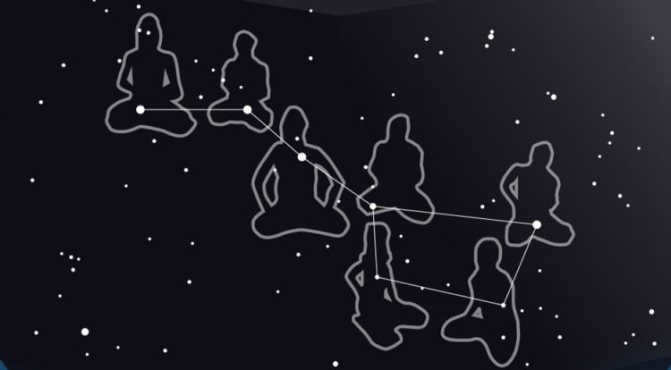
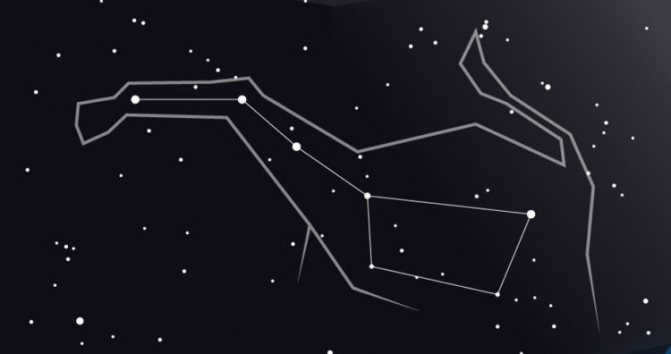
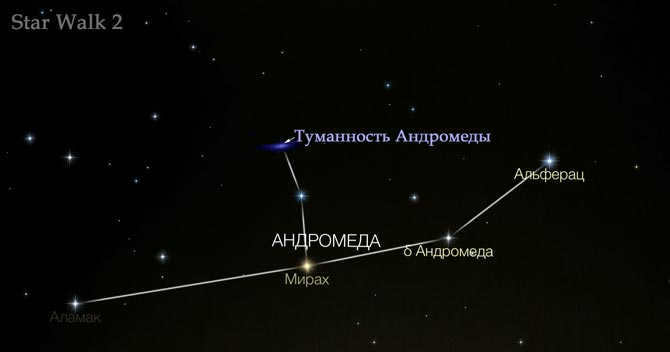
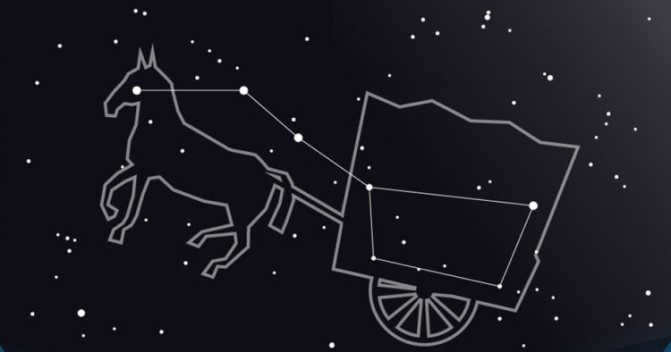
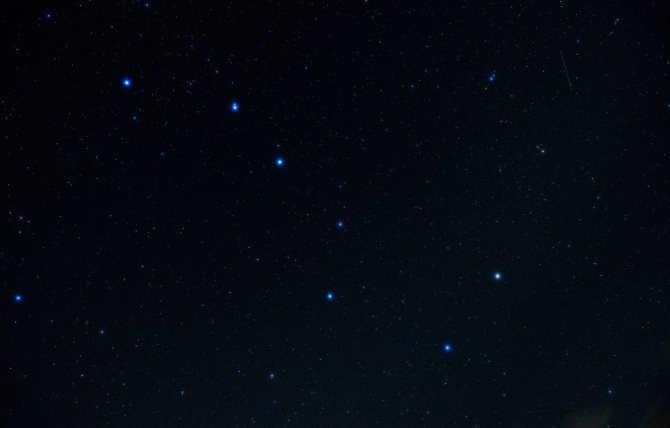
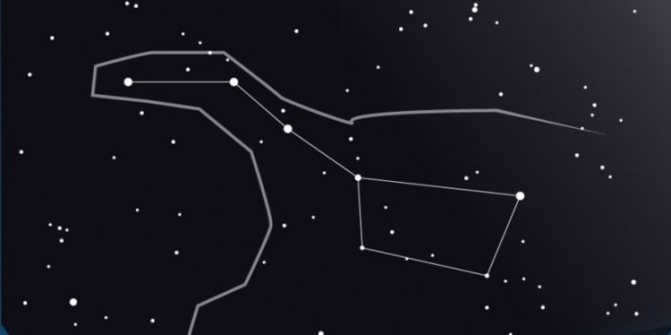
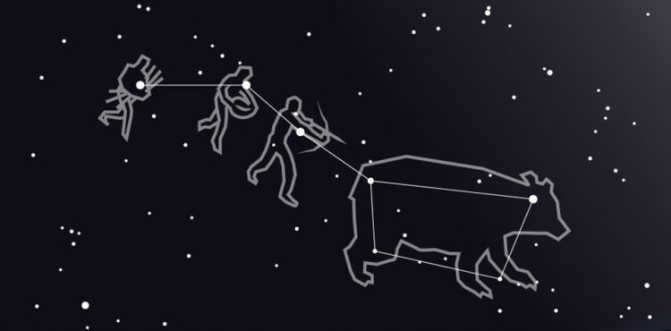
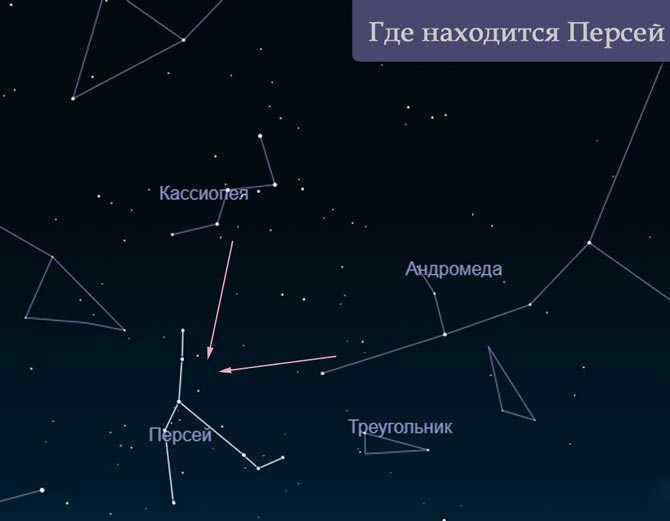
The Little Bear constellation is in the shape of a ladle, similar to the Big Dipper. The Phoenicians, who were renowned navigators in ancient times, used this group of stars for navigation. However, Greek sailors relied more on the Big Dipper for guidance. The Arabs perceived the Little Dipper as a rider, while the Indians saw it as a monkey that clings to the center of the world with its tail and orbits around it. It is evident that there was no universally agreed upon meaning or name for a long time, and each culture interpreted the night sky in a unique and easily understandable way. What other insights can the Big Dipper constellation offer?
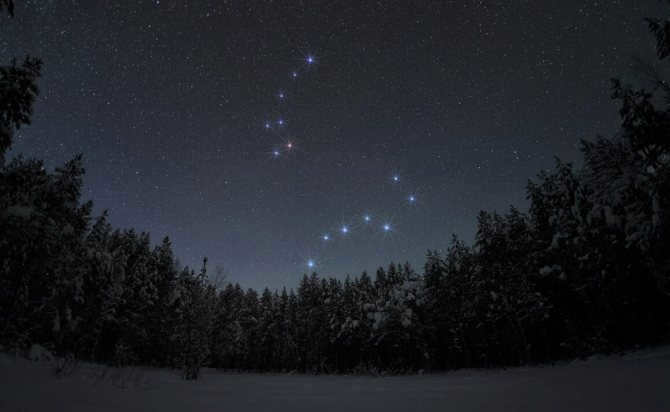
Image of the Ursa Major and Ursa Minor
Locating a constellation in the sky can be quite challenging without specialized equipment. However, the Ursa Major, also known as the Big Dipper, is relatively easy to find due to its well-defined shape. Once one locates this asterism, the problem of finding other constellations can be solved.
During late summer and early fall, the Ursa Major can be found in the northern part of the night sky. For optimal observation, it is recommended to wait until nighttime and venture outside of urban areas to minimize the interference of artificial lights from houses and street lamps.
Did you know? The position of the Sun at noon can be used to determine the north. At this time, the star will be located in the opposite direction, in the south.
During the autumn season, the asterism can be observed high in the celestial sphere with a horizontal orientation. The stars that form this group are sufficiently bright for the naked eye to easily perceive them, and our brain naturally connects them together, forming a recognizable shape.
As our planet revolves around the Sun and rotates on its axis, the arrangement of constellations in the night sky gradually changes depending on our vantage point. Due to this phenomenon, between the months of January and February, the Big Dipper undergoes a circular motion: the “bucket” tilts downwards from its original horizontal position, while the entire cluster slowly shifts towards the northeast.
During the spring season, locating the Big Dipper in the night sky becomes more challenging. At this time, the asterism is flipped upside down, making it less noticeable to those who are unaware of its true orientation.
Fascinating: Discover the wonders of stars and constellations with detailed descriptions, stunning photos, and captivating videos.
Unfortunately, in the northern regions of Russia, such as the Big Dipper, the stars are often hidden due to the phenomenon of white nights. However, in the middle and southern parts of the country, the Big Dipper can be observed with its handle pointing upwards.
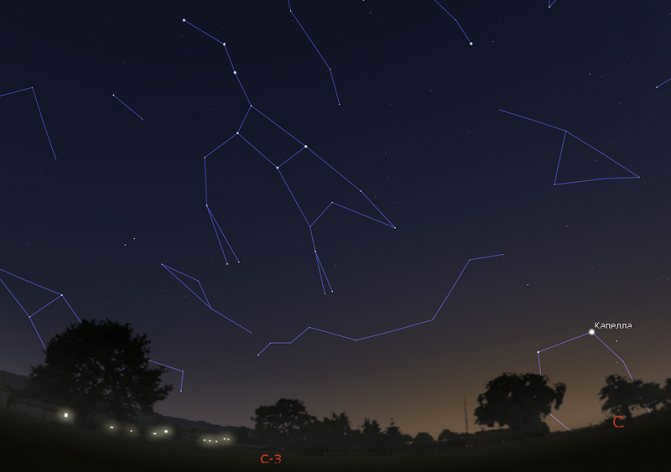
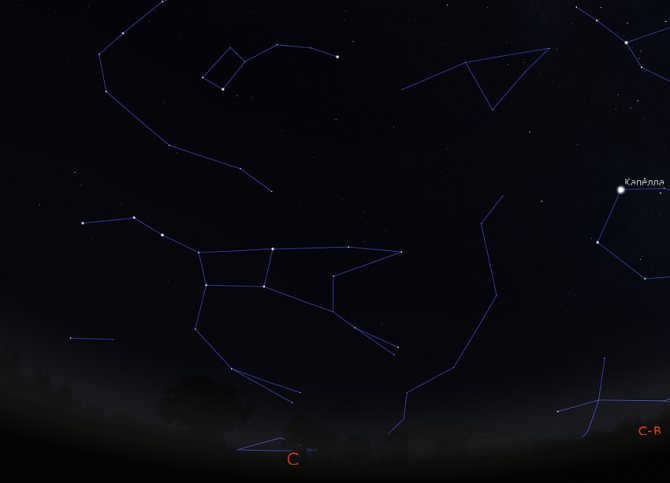
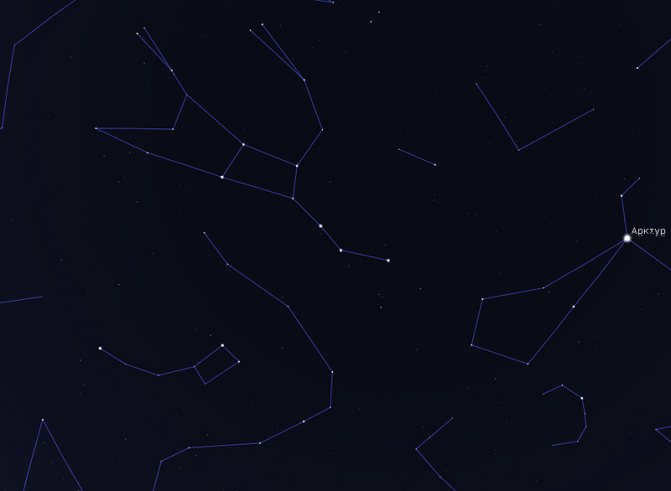
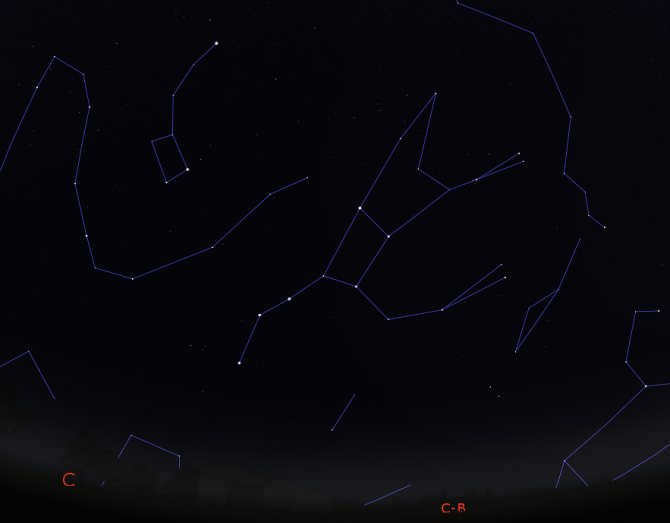
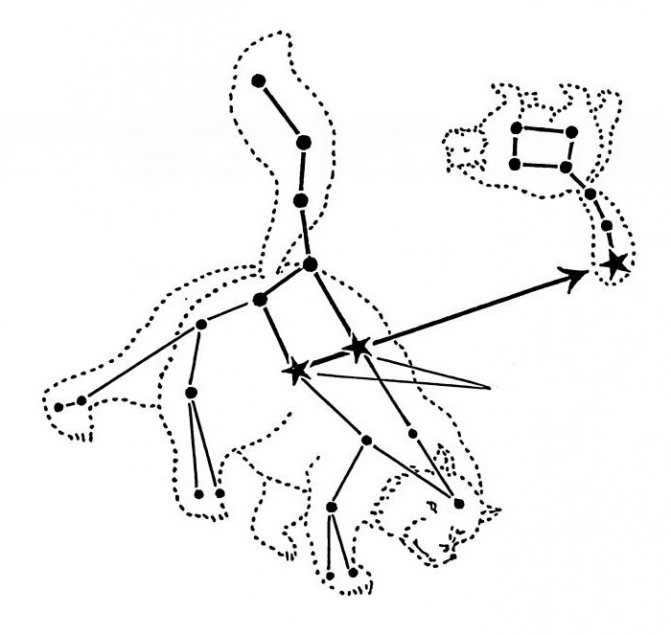
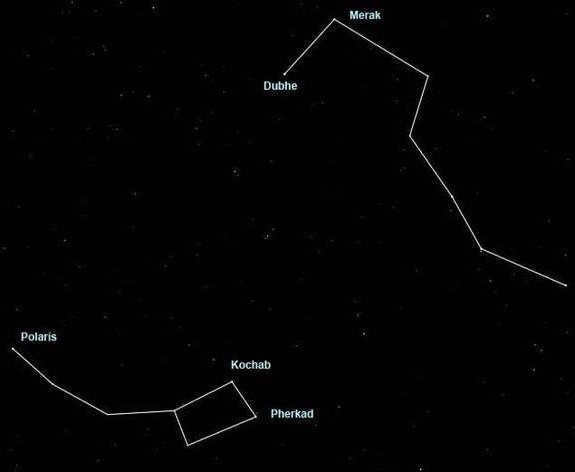
There is a heartwarming legend connected to the constellation of the Big Dipper and the Little Dipper. In a time long ago, in the midst of hills and valleys, stood an ordinary village. Within this settlement resided a large family, and within it grew a daughter named Aina. There was no one in the vicinity more kind-hearted than this young girl. One morning, a mysterious carriage appeared on the road leading to the village. It was pulled by ebony horses. Seated upon the carriage was a man dressed in dark attire. He had a wide smile on his face, exuding cheerfulness and occasionally bursting into laughter. On the carriage rested a somber cage, within which a polar bear cub was bound by chains. Tears of immense proportion streamed down the creature’s eyes. Many of the villagers were incensed: was it not disgraceful for such a towering, dark figure to keep a small polar bear cub restrained, subjecting it to torment and cruelty? The villagers were outraged, yet no further action was taken.
Ancient People’s Perspective on the Big Dipper
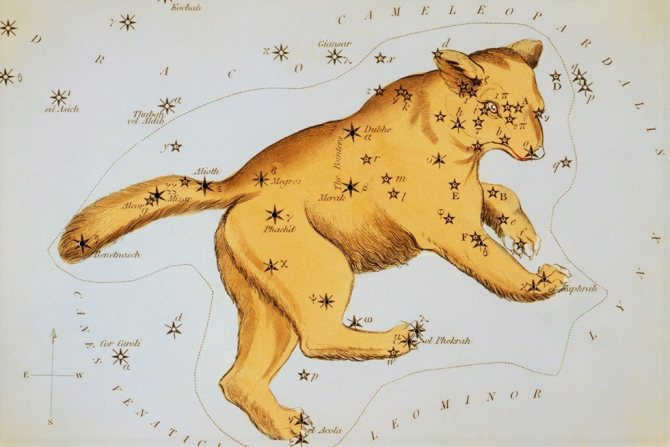
One of the options for the depiction of the Great Bear’s ladle on a celestial chart
The Great Bear’s ladle is known to be one of the most ancient constellations, as nearly all civilizations that have ever existed on Earth have made reference to it. The earliest mentions of this star cluster are discovered in India, where it was referred to as “Sapta Rishi” (seven sages). This name arose due to the presence of seven principal stars that constitute the Dipper. The Chinese also observed this formation and used its position in the sky to determine the time.
According to Greek mythology, the Big Dipper has a fascinating legend associated with it. It is said that Zeus, the Greek god, had a penchant for beautiful women. Callisto, the daughter of the king of Arcadia, caught his attention as well. However, Zeus’s wife, Hera, discovered their affair and sought revenge. To protect Callisto from Hera’s wrath, Zeus transformed her into a bear and placed her in the sky, where she would be safe.
In Indian mythology, the Big Dipper is also seen as a bear, but there is a slight variation in their interpretation. They believe that the bear is made up of four stars arranged in a trapezoid shape. Additionally, the handle of the Dipper represents three hunters chasing after the bear. Aliot, the first hunter, holds a bow, Mitzar carries a cauldron, and Benetnash brings a pile of brushwood to light a fire.
Myth of how the constellation came to be, as told by Greenlandic storytellers
Feeling hopeless, Eriulok ventured to the Arctic Ocean and summoned the goddess Arnarkuachssak, the ruler of the depths of the sea. He shared his story and troubles with her. The goddess offered her assistance, but on one condition: Eriulok must retrieve a ladle filled with enchanted berries that would restore her youth. Agreeing to the terms, the hunter set off to a distant island, where he discovered a cave guarded by a formidable bear. After enduring great hardship, he managed to lull the bear to sleep and pilfered the ladle containing the magical berries. True to her word, the goddess rewarded the hunter with a wife and presented him with the coveted berries. Following his extraordinary adventures, Eriulok married and became the proud father of a large family, the envy of all his neighbors. As for the goddess, she consumed all the berries and underwent a transformation, shedding centuries off her age. Overwhelmed with joy, she flung the empty ladle into the sky, where it became entangled and remained suspended.
Stars in the Big Dipper Constellation
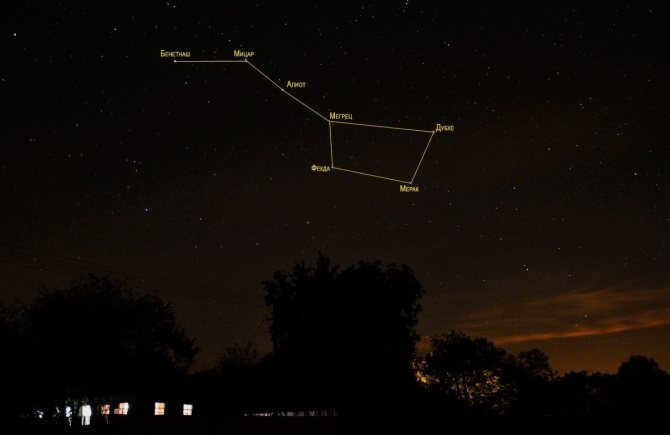
The primary celebrities of the Great Bear’s Bucket
The Great Bear’s Bucket is comprised of a remarkable number of celebs. However, within its asterism, there are only seven luminaries that form a distinct shape. Modern technology enables astronomers to continuously observe them and acquire the necessary information. The asterism of the Great Bear’s Bucket consists of:
- Dubhe – serves as the alpha and is considered the second brightest star in the constellation. Careful studies have revealed that Dubhe is composed of two luminaries: the main sequence and the orange giant.
- Merak is the beta of the cluster. While not considered the most prominent in the night sky, it shines 69 times brighter than the Sun.
- Fekda – a luminary situated at the bottom of the Bucket, below the knob.
- Aliot – the most prominent star in the cluster, easily visible in the night sky.
- Mizar – not very noticeable because the nearby star Alcor is almost twice as bright.
- Alkaid – the farthest luminary from the rest of the group, situated at the end of the Big Dipper’s handle.
In addition to the seven stars in the asterism, there are approximately 125 other stars in the constellation. However, only a few dozen of them can be seen with the naked eye. The three most prominent stars to the right of the Dubhe-Merak pair form a triangle. Similarly, in the lower right corner of the Big Dipper, there is another triangle formed by the stars lambda, mu, and psi.
Fun fact: in certain cultures, these two triangles represent the hind and front paws of a bear.
